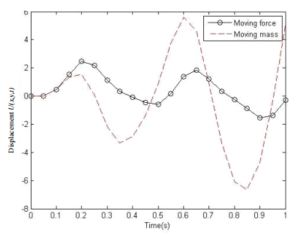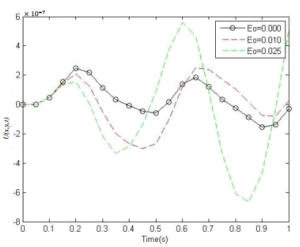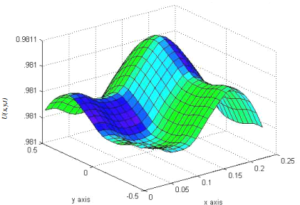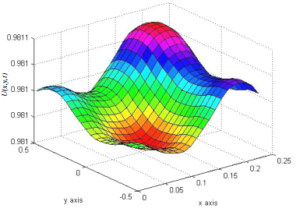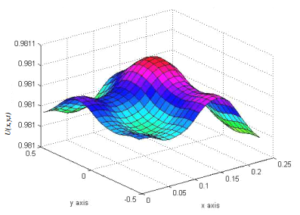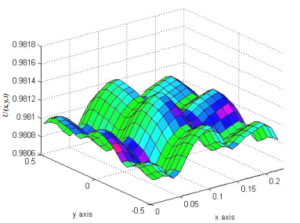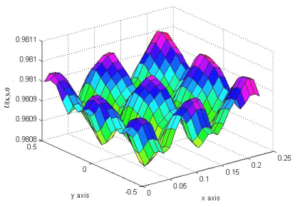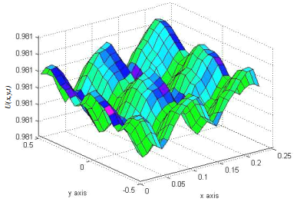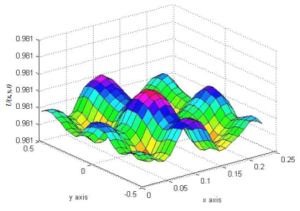1. Introduction
Plates are widely used structures with wide engineering applications in aircrafts, nuclear vessels, hydraulics, bridges and roads. There has been a great deal of research on the analysis of structures (shells, plates and beams) with consideration for various factors such as displacements, thickness variation, stresses, curvature, effect of surrounding media, loads and masses. In particular, the problem of moving masses and loads over plates and beams has been a subject of investigation in Mathematics, Physics and Engineering because of its extensive use in everyday life.
Several authors have in particular investigated the effect of shear deformations and rotary inertia on plates and beams including [1, 2] with focus on isotropic plates. There has been very little focus on anisotropic plates and in particular the effect of shear deformations and rotary inertia, with varying masses transversing the plates. According to Toorani and Lakis [3], transverse shear deformation plays a very important role in reducing the effective flexural stiffness of anisotropic laminated plates and shells because their in-plane elastic modulus to transverse shear modulus ratio is high. Toorani et al. [4] based on Kirchhoff-Love assumptions opined that shear deformation is more significant in laminated anisotropic plates than isotropic constructions. The researchers, in [1, 2, 4] worked on the effect of shear deformation and rotary inertia on anisotropic plates with consideration for flexural vibrations, wave amplitude and natural frequencies but not on moving loads. The problem moving loads transversing plates have received little attention unlike the effect of moving loads on isotropic plates and beams have also been studied by authors including [5, 6, 7] have given solutions using analytic and approximate methods such as he finite difference, Galerkin, Rayleigh-Ritz, transfer matrix and finite element methods. Kocaturk [8] studied rectangular anisotropic (orthotropic) plates on a tensionless elastic foundation and Ozgan [9] modeled laminated orthotropic plate-foundation interaction subjected to moving load using Vlasov model.
The present study modifies the Mindlin plate model which also incorporates both shear deformation and rotary inertia. The study employs varying flexural rigidity and varying mass per unit area in order to make the new model anisotropic.
This study is concerned with the effects of shear deformation and rotary inertia on the dynamics of moving concentrated masses on anisotropic plate resting on Vlasov foundation with simply supported boundary conditions.
2. Problem formulation
The general single equation of a plate which considered the influence of rotary inertia and shear on flexural motions of elastic plates was given by [
4]. The elastic Vlasov foundation \( Q(\xi,\eta,\tau)\) from [
10,
11] is given by:
\begin{align}
&\label{E1} Q(\xi,\eta,\tau)=(k-G_{d}\triangledown^{2})U(\xi,\eta,\tau),
\end{align}
(1)
where \(k\) and \(G\) depict the foundation modulus and shear deformation parameter of the elastic Vlasov foundation. Anisotropy of the plate: two mechanical properties of the plate are varying in different directions on the rectangular plate. The flexural rigidity of the plate \(D_d\) given by;
\begin{align}
&D_{d}(\xi,\eta)=D_{0}\left(1-\frac{2\xi}{a}+\frac{2\xi^{2}}{a^{2}}\right)\left(1-\frac{2\eta}{b}+\frac{2\eta^{2}}{b^{2}}\right)
\end{align}
(2)
and the mass per unit area of the plate \(\mu_{d}\) given by;
\begin{align}
&\mu_{d}(\xi,\eta)=\mu_{0}\left(1-\frac{2\xi}{a}+\frac{2\xi^{2}}{a^{2}}\right)\left(1-\frac{2\eta}{b}+\frac{2\eta^{2}}{b^{2}}\right).
\end{align}
(3)
2.1. Governing equation
The equation governing the anisotropic plate is given as;
\begin{align}\label{E4}
\nonumber
&\left( D_{d}(\xi,\eta)\triangledown^{2}-\left(\frac{\mu_{d}(\xi,\eta) D_{d}(\xi,\eta)}{hG_d}+R_{0}\right) \frac{\partial^{2}}{\partial \tau^{2}}\right)\triangledown^{2})U(\xi,\eta,\tau)+\frac{\mu_{d}(\xi,\eta)R_{0}}{hG_d}) \frac{\partial^{4}U(\xi,\eta,\tau)}{\partial \tau^{4}}\\
&+\mu_{d}(\xi,\eta)\frac{\partial^{2}U(\xi,\eta,\tau)}{\partial \tau^{2}}+(k-G_{f}\triangledown^{2})U(\xi,\eta,\tau)
\nonumber\\&=Mg\delta(x-v_\xi t)\delta(y-v_\eta t)\left(\frac{1}{g}\left[\frac{\partial^{2}}{\partial \tau^2}+\left(2V\frac{\partial^{}}{\partial \tau}+a\right)\left(\frac{\partial^{}}{\partial x}+\frac{\partial^{}}{\partial y}\right)+V^{2}\triangledown^{2}\right]U(\xi,\eta,\tau)\right),
\end{align}
(4)
where \(U(\xi,\eta,\tau)\) is the displacement of the plate \(\xi\) and \(\eta\) are spatial coordinates, \(\tau\) is the time coordinate, \(D_{d}\) is the variable flexural rigidity of the plate, \(\mu_{d}\) is the variable mass per unit area of the plate and \(D_{0}\) is the constant flexural rigidity of the plate, \(\mu_{0}\) is the constant mass per unit area of the plate. \(R_{0}\) is the rotary inertia correction factor, \(G_{d}\) is the shear modulus, \(P(\xi,\eta,\tau)\) is the load, \(M\) is the mass of the load \(v_\xi\) and \(v_\eta\) are the velocity components of the load.
2.2 Dimensionless form
The following dimensionless variables are introduced;
\begin{align}\label{E5}
x=\frac{\xi}{a},\quad y=\frac{\eta}{b},\quad t=\frac{\tau}{t_{0}},
\end{align}
(5)
where \(t_{0}\) will be specified and
\begin{align}\label{E6}
\mu=\frac{\mu_{d}}{\rho h},\quad D=\frac{D_{d}}{Eh^{3}},\quad \kappa=\frac{kh^3}{D},\quad P_{0}=\frac{Mgh^{2}}{D},\quad G=\frac{G_{d}h^3}{D},\quad V_{0}=\frac{V\tau}{h},\quad a_{0}=\frac{a\tau^{2}}{h}.
\end{align}
(6)
Substituting Equations (5) and (6) into Equation (4) and making some rearrangements yields:
\begin{align}\label{E7}
\nonumber
&D_{1}(F_x+F_y)\left(\frac{\partial^{2}U(x,y,t)}{\partial x^{2}}+\frac{\partial^{2}U(x,y,t)}{\partial y^{2}}\right)-b_{1}(F_xF_y)^{2}\left(\frac{\partial^{4}U(x,y,t)}{\partial t^{2}\partial x^{2}}+\frac{\partial^{4}U(x,y,t)}{\partial t^{2}\partial y^{2}}\right)\\
\nonumber
&-R_{0}\left(\frac{\partial^{4}U(x,y,t)}{\partial t^{2}\partial x^{2}}+\frac{\partial^{4}U(x,y,t)}{\partial t^{2}\partial y^{2}}\right)+b_{2}\mu(x,y)\frac{\partial^{4}U(x,y,t)}{\partial t^{4}}+b_{3}\mu_{0}F_xF_y\frac{\partial^{2}U(x,y,t)}{\partial t^{2}}+\kappa_{f}U(x,y,t)\\
&-G_{f}\left(\frac{\partial^{4}U(x,y,t)}{\partial t^{2}\partial x^{2}}+\frac{\partial^{4}U(x,y,t)}{\partial t^{2}\partial y^{2}}\right)
=P_{0}\delta(x-v_\xi t)\delta(y-v_\eta t)-\frac{P_{0}}{g}\delta(x-v_\xi t)\delta(y-v_\eta t)\nonumber\\
&\left[b_{3}\frac{\partial^{2}U(x,y,t)}{\partial t^{2}}+\left(c_{0}\frac{\partial{}}{\partial t}+a_{0}\right)\left(\frac{\partial{}}{\partial x}+\frac{\partial{}}{\partial y}\right)U(x,y,t)+V_{0}^{2}\left(\frac{\partial^{2}U(x,y,t)}{\partial x^{2}}+\frac{\partial^{2}U(x,y,t)}{\partial y^{2}}\right)\right],
\end{align}
(7)
where
\begin{equation}
\label{E8}
\left. \begin{array}{c}
D_1=\frac{4D_0}{Eh^5},\; b_1=\frac{\mu_0D_0}{EGD\rho^{2}t_{0}^{2}},\; b_2=\frac{R_0 h^6}{GDt_{0}^{4}},\; b_3=\frac{h^6}{t_{0}^{2}},\; k_f=\frac{\kappa D}{h^2},\; G_f=\frac{GD}{h^3},\; V_0=\frac{Vh^2}{t_{0}^{2}},\; a_0=\frac{ah^2}{t_{0}^{2}},\\ c_0=\frac{2V_0}{t_{0}},\; F_x=1-2x+2x^2\; F_y=1-2y+2y^2\; F_{xy}^2=(1-2x+2x^2)^2(1-2y+2y^2)^2.
\end{array}
\right\} \end{equation}
(8)
Also the varying flexural rigidity and varying mass per unit area becomes:
\begin{equation}
\label{E9}
\left. \begin{array}{c}
D(x,y)=\frac{D_0}{h^3}(1-2x+2x^2)(1-2y+2y^2)\\
\mu (x,y)=\frac{\mu_o}{\rho h}(1-2x+2x^2)(1-2y+2y^2)
\end{array}
\right\} \end{equation}
(9)
Considering the case (simply supported) with the boundary conditions:
\begin{equation}
\label{E10}
\left. \begin{array}{c}
U(0,y,t)=0=U(1,y,t)=0;\quad U_{xx}(0,y,t)=0=U_{xx}(1,y,t)=0; \text{ for }\; 0\leq x\leq 1\\
\text{and }
U(x,0,t)=0=U(x,1,t)=0;\quad U_{yy}(x,0,t)=0=U_{yy}(x,1,t)=0; \text{ for }\; 0\leq y\leq 1.
\end{array}
\right\} \end{equation}
(10)
The initial condition taken as;
\begin{equation}
\label{E11}
\left. \begin{array}{c}
U(x,y,t)|_{t=0}=U_0, \quad U_{t}(x,y,t)|_{t=0}=0\\
U_{tt}(x,y,t)|_{t=0}=0, \quad U_{ttt}(x,y,t)|_{t=0}=0.
\end{array}
\right\} \end{equation}
(11)
3. Method of Solution
The method of analysis involved in solving (7) subject to conditions (10) and (11) requires the use of the Galerkin's method to separate variables and reduce the fourth order partial differential equation governing plates to a set of coupled fourth order ordinary differential equation. Also the Dirac-Delta function is expressed as a Fourier series Cosine.
In order to solve (7), the displacement written in the form:
\begin{align}
U(x,y,t)=\sum_{m=1}^{\infty}\Lambda_m (x,y)y_m(t),
\end{align}
(12)
where \(\Lambda_m (x,y)\) are the known eigen-functions of the plate with the same boundary conditions.
We obtain the value of \(\Lambda_m (x,y)\) by considering the free vibration of rectangular plates given by;
\begin{align}
\triangledown^{4}\Lambda_m-\frac{\mu}{ D}\Omega_m^2\Lambda_m=0,
\end{align}
(13)
where
\begin{align}
\frac{\mu}{ D}\Omega_m^2\Lambda_m=W_m^4
\end{align}
(14)
\(\Omega_m\), \(m=1,2,3...\) are the natural frequencies of the dynamic system and \(y_m(t)\) are amplitude functions which have to be solved.
\(\Lambda_n(x,y)\) are assumed to be products of the function \(\phi_{ni}(x)\) and \(\phi_{nj}(y)\) which are plate functions in the direction of axes respectively. Hence
\begin{align}
\Lambda_n(x,y)=\phi_{ni}(x)\phi_{nj}(y).
\end{align}
(15)
Each of these plate functions satisfies all the boundary conditions in its direction respectively. In particular, these plate functions can be defined respectively as:
\begin{equation}
\label{E16}
\left. \begin{array}{c}
\phi_{ni}(x)=\sin \frac{\psi_{ni} x}{L_x}+A_{ni}\cos \frac{\psi_{ni} x}{L_x}+B_{ni}\sinh \frac{\psi_{ni} x}{L_x+}+C_{ni}\cosh \frac{\psi_{ni} x}{L_x};\\
\phi_{nj}(y)=\sin \frac{\psi_{ni} y}{L_y}+A_{nj}\cos \frac{\psi_{ni} y}{L_y}+B_{nj}\sinh \frac{\psi_{nj} y}{L_y+}+C_{nj}\cosh \frac{\psi_{nj} y}{L_y},
\end{array}
\right\} \end{equation}
(16)
where \(A_{ni}\), \(B_{ni}\), \(C_{ni}\), \(A_{nj}\) and \(B_{nj}\), \(C_{nj}\) are constants determined by the boundary conditions. \(\psi_{ni}\) and \(\psi_{nj}\) are called modal frequencies.
When the anisotropic plate has arbitrary end support conditions since the plate under consideration has simple support at all its edges, (16) becomes:
\begin{align}
\phi_{ni}(x)=\sin \frac{n_{i}\pi x}{L_x}, \quad \phi_{nj}(y)=\sin \frac{n_{j}\pi y}{L_y}.
\end{align}
(17)
Therefore the non-dimensional plate function is given as:
\begin{align}
\phi_{ni}(x)=\sin{n_{i}\pi x}, \quad \phi_{nj}(y)=\sin{n_{j}\pi y}.
\end{align}
(18)
3.1. Transformation of the governing equation
By applying the Generalized Galerkin's method Equation (7) is transformed to
\begin{align}\label{E19}
\nonumber
&\sum_{m=1}^{\infty}\Biggl[\left(\frac{D_1}{\mu_0}(F_x+F_y)\right)\left[\Lambda_{m,xx}(x,y)y_m(t)+\Lambda_{m,yy}(x,y)y_m(t)\right]\\
\nonumber
&-\frac{b_1(F_xF_y)^2}{\mu_0}\left[\Lambda_{m,xx}(x,y)\ddot{y}_m(t)+\Lambda_{m,yy}(x,y)\ddot{y}_m(t)\right]-\frac{R_0}{\mu_0}\left[\Lambda_{m,xx}(x,y)\ddot{y}_m(t)+\Lambda_{m,yy}(x,y)\ddot{y}_m(t)\right]\\
\nonumber
&+\frac{b_2}{\mu_0}\mu(x,y)\Lambda_{m}(x,y)\ddddot{y}_m(t)+b_3F_xF_y\Lambda_{m}(x,y)\ddot{y}_m(t)+\frac{k_f}{\mu_0}\Lambda_{m}(x,y)y_m(t)\\ \nonumber
&-\frac{G_f}{\mu_0}\left[\Lambda_{m,xx}(x,y)y_m(t)+\Lambda_{m,yy}(x,y)y_m(t)\right]+\frac{P_{0}}{\mu_0g}\delta(x-v_\xi t)\delta(y-v_\eta t)\left(b_3\Lambda_{m}(x,y)\ddot{y}_m(t)\right)\\
\nonumber
&\left(b_3\Lambda_{m}(x,y)\ddot{y}_m(t)\right)+c_0\left[\Lambda_{m,x}(x,y)\dot{y}_m(t)+\Lambda_{m,y}(x,y)\dot{y}_m(t)\right]+a_0\left[\Lambda_{m,x}(x,y)y_m(t)+\Lambda_{m,y}(x,y)y_m(t)\right]\\
&+V_0^2\left[\Lambda_{m,xx}(x,y)y_m(t)+\Lambda_{m,yy}(x,y)y_m(t)\right]=\frac{P_{0}}{\mu_0g}\delta(x-v_x t)\delta(y-v_y t)
\Biggr],
\end{align}
(19)
where
\begin{equation}
\label{E20}
\left. \begin{array}{c}
\Lambda_{m,x}(x,y)=\frac{\partial{}}{\partial x}\Lambda_{m}(x,y), \quad \Lambda_{m,y}(x,y)=\frac{\partial{}}{\partial y}\Lambda_{m}(x,y)\\
\Lambda_{m,xx}(x,y)=\frac{\partial^2{}}{\partial x^2}\Lambda_{m}(x,y), \quad \Lambda_{m,yy}(x,y)=\frac{\partial^2{}}{\partial y^2}\Lambda_{m}(x,y)\\
\dot{y}_m(t)=\frac{dy_m(t)}{dt},\quad \ddot{y}_m(t)=\frac{d^2y_m(t)}{dt^2},\quad \ddddot{y}_m(t)=\frac{d^4y_m(t)}{dt^4}.
\end{array}
\right\} \end{equation}
(20)
Using the property of the Dirac-delta functions and expressing it in the Fourier Cosine series (because it is an even function) as,
\begin{align} \begin{split}
\delta(x-v_x t)=\frac{1}{L_x}\left(1+2 \sum_{j=1}^\infty \cos\frac{j\pi v_xt}{L_x}\cos\frac{j\pi x}{L_x}\right)\\
\end{split} \end{align}
(21)
\begin{align} \begin{split}
\delta(y-v_y t)=\frac{1}{L_y}\left(1+2 \sum_{k=1}^\infty \cos\frac{k\pi v_yt}{L_y}\cos\frac{k\pi y}{L_y}\right).
\end{split} \end{align}
(22)
Multiplying both sides of Equation (19) by \(\Lambda_{n}(x,y)\) in view of the orthogonality of \(\Lambda_{m}(x,y)\) and integrating on Area (A) of the plate yields, the simplified equation:
\begin{align}\label{E23} \nonumber
&\frac{d^4y_p(t)}{dt^4}+\alpha_1^2\frac{d^2y_p(t)}{dt^2}+\alpha_2^2y_p(t)+\epsilon_0\Biggl[\Biggl(I_{01}I_{02}+2\sum_{j=1}^\infty \cos j\pi v_xt I_{41}^jI_{02}+2\sum_{k=1}^\infty \cos k\pi v_yt I_{42}^kI_{01}\\
\nonumber
&+4\sum_{j=1}^\infty \sum_{k=1}^\infty \cos j\pi v_xt \cos k\pi v_yt I_{41}^j I_{42}\Biggr)\frac{d^2y_p(t)}{dt^2}
+\Biggl( a_1I_{51} I_{02}+ b_1I_{01} I_{52}+2\sum_{j=1}^\infty \cos j\pi v_xt( a_1I_{51}^j I_{02}+ b_1I_{41}^j I_{52})\\
\nonumber
&+2\sum_{k=1}^\infty \cos k\pi v_yt( a_1I_{51} I_{42}^k+ b_1I_{01} I_{52}^k)+4\sum_{j=1}^\infty \sum_{k=1}^\infty \cos j\pi v_xt \cos k\pi v_yt( a_1I_{51}^j I_{42}^k+ b_1I_{41}^j I_{52}^k) \Biggr)\\ \nonumber
&\times \Biggl(c_0\frac{dy_p(t)}{dt}+a_0y_p(t)\Biggr)+v_0\Biggl((a_1^2+b_1^2)I_{01} I_{02}+2\sum_{j=1}^\infty(a_1^2+b_1^2) \cos j\pi v_xt I_{41}^jI_{02}\\
\nonumber
&+2\sum_{k=1}^\infty(a_1^2+b_1^2) \cos k\pi v_yt I_{42}^kI_{01}+4\sum_{j=1}^\infty \sum_{k=1}^\infty(a_1^2+b_1^2) \cos j\pi v_xt \cos k\pi v_yt I_{41}^j I_{42}^k\Biggr)y_p(t)\Biggr]\\
&=\frac {P_0}{\mu_0D_3I_{B11}I_{B12}}\sin n_i\pi v_xt\sin n_j\pi v_yt,
\end{align}
(23)
where
\begin{equation}
\label{E24} \left. \begin{array}{c}
\epsilon_0=\frac{P_0}{L_xL_y\mu_0g}, \quad \alpha_1^2=\frac{B_2}{B_1}, \quad \alpha_2^4=\frac{B_3}{B_1}\\
B_1=D_3\int_0^1\int_0^1F_{xy}\sin p_i\pi v_xt\sin n_i\pi v_xt\sin p_j\pi v_yt\sin n_j\pi v_yt\;dydx\\
B_2=D_4I_{B11}I_{B12}+D_5(a_1^2+b_1^2)I_{2B1}I_{2B2}+D_6(a_1^2+b_1^2)I_{01}I_{02}\\
B_3=-D_{7a}(a_1^2+b_1^2)I_{B11}I_{02}-D_{7a}(a_1^2+b_1^2)I_{01}I_{12}+D_kI_{01}I_{02}-D_G(a_1^2+b_1^2)I_{01}I_{02}\\
D_3=\frac{b_2}{\mu_0},\\ D_4=b_3,\\ D_5=\frac{b_1}{\mu_0},\\ D_6=\frac{R_0}{\mu_0},\\ D_7=\frac{D_1}{\mu_0},\\ D_k=\frac{k_f}{\mu_0},\\ D_G=\frac{G_f}{\mu_0}\\
I_{01}=\int_0^1\sin p_i\pi x\sin n_i\pi x\;dx,\\ I_{02}=\int_0^1\sin p_j\pi y\sin n_j\pi y\;dy\\
I_{41}^j=\int_0^1\sin p_i\pi x\sin n_i\pi x \cos j\pi x\;dx,\\ I_{42}^k=\int_0^1\sin p_j\pi y\sin n_j\pi y\cos k\pi y\;dy\\
I_{51}=\int_0^1\cos p_i\pi x\sin n_i\pi x\;dx,\\ I_{52}=\int_0^1\cos p_j\pi y\sin n_j\pi y\;dy\\
I_{51}^j=\int_0^1\cos p_i\pi x\sin n_i\pi x\cos j\pi x\;dx,\\ I_{52}^k=\int_0^1\cos p_j\pi y\sin n_j\pi y\cos k\pi y\;dy\\
I_{B11}=\int_0^1(1-2x+2x^2)\sin p_i\pi x\sin n_i\pi x\;dx,\\ I_{B12}=\int_0^1(1-2y+2y^2)\sin p_j\pi y\sin n_j\pi y\;dy.\\
\end{array}
\right\} \end{equation}
(24)
Implementing the integrals above and substituting into Equation (23) yields;
\begin{align}\label{E25} \begin{split}
\frac{d^4y_p(t)}{dt^4}+\left(\alpha_1^2+\frac{\epsilon_0}{4}\right)\frac{d^2y_p(t)}{dt^2}+c_0\epsilon_0\Delta_1^2\frac{dy_p(t)}{dt}+(\alpha_2^2+\epsilon_0\Delta_2^2)y_p(t)=P_f\sin n_i\pi x\sin n_j\pi y,
\end{split} \end{align}
(25)
where
\begin{equation}
\label{E26}
\left. \begin{array}{c}
\Delta_1^2=\frac{a_1\left[(p_i+n_i)(-1)^{p_i-n_i}-(p_i-n_i)(-1)^{p_i+n_i}-2n_i\right]}{4\pi(p_i^2-n_i^2)}
+ \frac{b_1\left[(p_i+n_i)(-1)^{p_i-n_i}-(p_i-n_i)(-1)^{p_i+n_i}-2n_i\right]}{4\pi(p_i^2-n_i^2)}\\
+\frac{4n_i}{\pi}\sum_{j=0}^\infty\cos j\pi v_xt\left(a_1\frac{n_i^2-p_i^2-j_i^2}{\left[j_i^2-(p_i+n_i)^2\right]\left[j_i^2-(p_i-n_i)^2\right]}\right)
+\frac{4n_j}{\pi}\sum_{k=0}^\infty\cos k\pi v_yt\left(a_1\frac{n_j^2-p_j^2-k_j^2}{\left[k_j^2-(p_j+n_j)^2\right]\left[k_j^2-(p_j-n_j)^2\right]}\right)\\
\Delta_2^2=a_1\Delta_1^2-\frac{V_0(a_2^2+b_2^2)}{4}\\
P_f=\frac{P_0}{\mu_0D_3I_{B11}I_{B12}}.
\end{array}
\right\}
\end{equation}
(26)
Equation (25) is the transformed forth order differential equation which represents the problem of anisotropic plate on Vlasov foundation with simply supported boundary conditions.
We consider two possible solution cases.
3.2. Case I: Moving force
An approximate model of the differential equation describing the response of anisotropic plates on Vlasov foundation is obtained by neglecting the inertia term \(\epsilon_0=0\). Hence Equation (25) becomes:
\begin{align}\label{E27} \begin{split}
\frac{d^4y_p(t)}{dt^4}+\alpha_1^2\frac{d^2y_p(t)}{dt^2}+\alpha_2^2y_p(t)=P_f\sin n_i\pi x\sin n_j\pi y.
\end{split} \end{align}
(27)
Subjecting (27) to a Laplace transform we us initial boundary conditions (11) yields;
\begin{align}\label{E28} \nonumber
&U(x,y,t)=\sum_{n_i=1}^\infty \sum_{n_j=1}^\infty\frac{1}{w_{f1}^2-w_{f2}^2}\Biggl(\frac{P_f}{2}\Bigl(\frac{1}{(w_{f2}^2-\theta_1^2)(w_{f2}^2-\theta_2^2)}[(w_{f2}^2-\theta_2^2)(\cos \theta_1t-\cos w_{f2}t)\\
&-(w_{f2}^2-\theta_1^2)(\cos \theta_2t-\cos w_{f2}t)]
(\frac{1}{(w_{f1}^2-\theta_1^2)(w_{f1}^2-\theta_2^2)}[(w_{f1}^2-\theta_2^2)(\cos \theta_1t-\cos w_{f1}t)\nonumber\\
\nonumber
&-(w_{f1}^2-\theta_1^2)(\cos \theta_2t-\cos w_{f1}t)]\Bigr)+[(\alpha_1^2-w_{f2}^2)\cos w_{f2}t)-(\alpha_1^2-w_{f1}^2)\cos w_{f1}t)]y_0 \Biggr)\sin \frac{n_i\pi x}{l_x}\sin \frac{n_j\pi y}{l_y},\nonumber\\&
\end{align}
(28)
which is the transverse displacement response to a moving varying force by a simply supported anisotropic plate on a Vlasov foundation.
\begin{equation}
\label{E29}
\left. \begin{array}{c}
w_{f1}^2=\frac{1}{2}\left[\alpha_1^2-\sqrt{\alpha_1^4-4\alpha_2^2}\right]\\
w_{f2}^2=\frac{1}{2}\left[\alpha_1^2+\sqrt{\alpha_1^4-4\alpha_2^2}\right]
\end{array}
\right\} \end{equation}
(29)
3.3. Case II: Moving mass
We consider the moving mass problem where the inertia term \(\epsilon_0\) is not neglected. And Equation (25) remains;
\begin{align}\label{E30} \begin{split}
\frac{d^4y_p(t)}{dt^4}+\left(\alpha_1^2+\frac{\epsilon_0}{4}\right)\frac{d^2y_p(t)}{dt^2}+c_0\epsilon_0\Delta_1^2\frac{dy_p(t)}{dt}+(\alpha_2^2+\epsilon_0\Delta_2^2)y_p(t)=P_f\sin n_i\pi x\sin n_j\pi y.
\end{split} \end{align}
(30)
To solve (25), we use an approximate analytic solution a modification of the asymptotic method due to Strubble's technique as used by [
12,
13,
14]. To this end, a modified frequency corresponding to the frequency of the free system due to the presence of the effect of the moving mass is sought by using:
\begin{align} \begin{split}
\frac{d^2y_p(t)}{dt^2}+\alpha_{mn}^2y_p(t)=0,
\end{split} \end{align}
(31)
where
\begin{align}\label{E32} \begin{split}
\alpha_{mn}=\alpha_2\left[1-\frac{1}{2\alpha_1^4}\left(\alpha_1^2(\alpha_1^2-1)+\frac{\epsilon_0}{\alpha_2^2}(\alpha_2^2-\Delta_{ij}\alpha_1^2)\right)\right]
\end{split} \end{align}
(32)
\(\alpha_{mn}\) is called the modified natural frequency representing the frequency of the system due to the effect of the foundation. Hence, Equation (30) can be rewritten as:
\begin{align}\label{E33} \begin{split}
\frac{d^4y_p(t)}{dt^4}+\frac{d^2y_p(t)}{dt^2}+\alpha_{mn}^2y_p(t)=P_f\sin n_i\pi x\sin n_j\pi y.
\end{split} \end{align}
(33)
Solving (33) using Laplace transforms method subject to initial boundary conditions (11) yields:
\begin{align}\label{E34} \nonumber
&U(x,y,t)=\sum_{n_i=1}^\infty \sum_{n_j=1}^\infty\frac{1}{w_{m1}^2-w_{m2}^2}\Biggl(\frac{P_f}{2}\Bigl(\frac{1}{(w_{m2}^2-\theta_1^2)(w_{m2}^2-\theta_2^2)}[(w_{m2}^2-\theta_2^2)(\cos \theta_1t-\cos w_{m2}t)\\
&-(w_{m2}^2-\theta_1^2)(\cos \theta_2t-\cos w_{m2}t)]
-(\frac{1}{(w_{m1}^2-\theta_1^2)(w_{m1}^2-\theta_2^2)}[(w_{m1}^2-\theta_2^2)(\cos \theta_1t-\cos w_{m1}t)\nonumber\\
\nonumber
&-(w_{m1}^2-\theta_1^2)(\cos \theta_2t-\cos w_{m1}t)]\Bigr)+[(1-w_{m1}^2)\cos w_{m1}t)-(1-w_{m2}^2)\cos w_{m2}t)]y_0 \Biggr)\sin \frac{n_i\pi x}{l_x}\sin \frac{n_j\pi y}{l_y},\nonumber\\&&
\end{align}
(34)
which is the transverse displacement response to a moving varying mass by a simply supported anisotropic plate on a Vlasov foundation. Where
\begin{equation}
\label{E35}
\left. \begin{array}{c}
w_{m1}^2=\frac{1}{2}\left[\alpha_1^2-\sqrt{1-4\alpha_{mn}^2}\right]\\
w_{m2}^2=\frac{1}{2}\left[\alpha_1^2+\sqrt{1-4\alpha_{mn}^2}\right]
\end{array}
\right\} \end{equation}
(35)
3.4 Resonance
We consider the resonance which takes place when the displacement of the vibrating structure becomes unbounded. In actual practice, when this happens the structure would collapse as the intensive vibrations causes cracks or permanent deformation in the vibrating system. Therefore, the conditions under which the solutions (28) and (34) grow without bound are investigated. The anisotropic plate traversed by moving force in Equation (28) will reach the state of resonance whenever:
\begin{equation}
\left. \begin{array}{c}
w_{f1}= \theta_1 and w_{f2}= \theta_1\\
w_{f2}= \theta_2 and w_{f2}= \theta_2.
\end{array}
\right\} \end{equation}
(36)
Similarly, Equation (34) shows that the same plate under moving concentrated mass will experience resonance effect whenever:
\begin{equation}
\left. \begin{array}{c}
w_{m1}= \theta_1 and w_{m2}= \theta_1\\
w_{m1}= \theta_2 and w_{m2}= \theta_2.
\end{array}
\right\} \end{equation}
(37)
From Equation (\ref{E35})
\begin{align}
\frac{1}{2}\left[\alpha_1^2-\sqrt{1-4\alpha_{mn}^2}\right]-\frac{1}{2}\left[\alpha_1^2+\sqrt{1-4\alpha_{mn}^2}\right]=0.
\end{align}
(38)
Hence
\begin{align} \begin{split}
\alpha_{mn}=\pm\frac{1}{2}.
\end{split} \end{align}
(39)
Similarly from \ref{E29}
\begin{align}
\frac{1}{2}\left[\alpha_1^2-\sqrt{\alpha_1^4-4\alpha_2^2}\right]-\frac{1}{2}\left[\alpha_1^2+\sqrt{\alpha_1^4-4\alpha_2^2}\right]=0.
\end{align}
(40)
Hence
\begin{align} \begin{split}
\alpha_{1}^{2}=\pm2\alpha_{2}.
\end{split} \end{align}
(41)
Now, from Equation (32), we have \(\alpha_{mn}=\alpha_2\left[1-\frac{1}{2\alpha_1^4}\left(\alpha_1^2(\alpha_1^2-1)+\frac{\epsilon_0}{\alpha_2^2}(\alpha_2^2-\Delta_{ij}\alpha_1^2)\right)\right]\).
And
\begin{align} \begin{split}
\alpha_{2}\left(\frac{\alpha_2^3+2\alpha_2^2-\epsilon_0(\alpha_2-2\Delta_{ij})}{8\alpha_2^3}\right)< 1.
\end{split} \end{align}
(42)
From equation above, it is evident that for the same natural frequency, the critical velocity for the system of the plate moving force is greater than that of the moving mass problem. Thus, for the same natural frequency of the anisotropic plate, resonance is reached earlier in the moving mass than in the moving force system.
Discussion and Analysis
A rectangular plate of breadth \(L_x=0.456\) and length \(L_y=0.946\) was used as sample to carry out numerical experiments on the dynamics of the anisotropic plate. The velocity of the plate was assumed to be \(0.8m/s\) and the Young's modulus \(E=1\times10^9 kg/m^2\).
A comparison of the displacement of structure-load force and structure-load mass system of anisotropic plate on Vlasov foundation is given in Figure 1 showing a larger displacement for the moving mass system. While Figure 2 and Figure 3 show the effects of Rotary inertia \((R_0)\) on the anisotropic plate for the moving force and moving mass problems respectively. In both cases, increasing Rotary inertia \((R_0)\) reduces the displacement.

